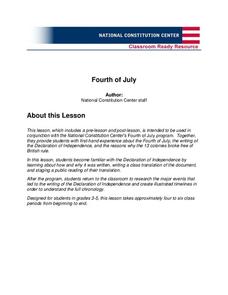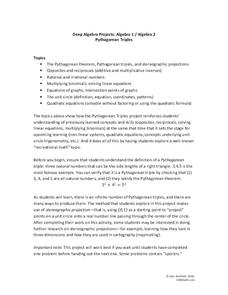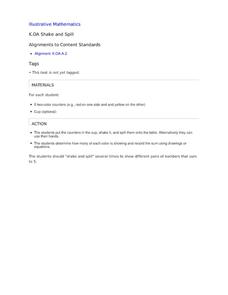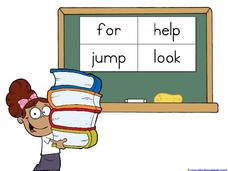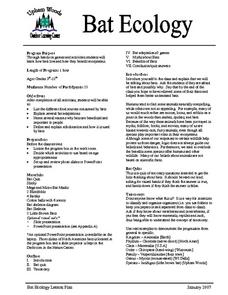Facebook
Privacy and You
The stuff I share goes where? Social media scholars discover how sites collect and use metadata during a lesson about privacy and reputation. The activity demonstrates smart privacy settings and promotes good digital citizenship.
Lakeshore Learning
Winter Bear Warm-Up
Don't be left out in the cold, ensure young learners are prepared for the winter weather with this clothing activity. After introducing them to different clothing items using the provided picture cards, students sing a song before...
Teach Engineering
Bridge Types: Tensile and Compressive Forces
Bridges rely on tension and compression to keep them standing. Pairs test this principle by constructing simple bridges and applying a force to the center. Teams use the provided worksheet to record their observations of the reaction of...
Get Reading Right
Picture and Word Cards
Reading and recognizing words with the long /e/ sound is enjoyable and accessible for all emerging readers with these picture and word cards. Print, laminate, and play games in small groups or with additional classroom personnel. Two...
Curated OER
Time
Introduce kids to the wonders of telling time. A variety of time telling devices are used to show what time it is. Kids will read each clock or watch to determine the correct time. Tip: This would be a great tool to use at an independent...
Curated OER
Shaping Up!
Kindergartners are introduced to basic shapes. Learners spend 45 minutes a day in geometry centers carrying out the activities outlined in this ambitious plan. There are games, hands-on activities, interactive websites, art projects,...
Curated OER
Excited About Flight!
Students create flying objects by using materials given in 3 different flight centers. In this flight lesson plan, students go to each center and have a discussion about each one.
Curated OER
Out and About: Sound
Pupils visit science museums. In this hands-on science activity, students visit the Magna Science Adventure Center, Thinktank, and the Museum of Science and Industry.
National Constitution Center
Fourth of July (Grades 3-5)
Bring history to life for your young scholars with a Fourth of July lesson series. After a class reading of the Declaration of Independence, students translate this pivotal document into layman's terms before working in small groups to...
Baylor College
Needs of Plants
What better way to learn about plant life than by creating a class garden? Young botanists start with a brief discussion about radishes before planting seeds and watching them grow. To determine the importance of water, sunlight, and...
5280 Math
Pythagorean Triples
From Pythagorean triples to the unit circle. Learners use the Pythagorean Theorem to find Pythagorean triples and then relate their work to the unit circle in a fun algebra project. Their discovery that x^2+y^2 is always equal to one on...
Curated OER
A Listening Doll: Create Traditional Native American Storyteller Dolls
In this wonderful cross-curricular lesson, your youngsters will learn about Pueblo Indian storyteller dolls by creating their own! They discuss the tradition of story telling, especially in reference to Native Americans. Consider ending...
It's About Time
Circular Motion
Lead your class in this exciting activity to learn more about motion and its importance. Pupils learn about a centripetal and why it is required to maintain a constant speed in a circulating moving mass. They apply the equation for...
National Endowment for the Humanities
The Rise and Fall of Joseph McCarthy
"I have here in my hand . . ." The war against Communism and Joseph McCarthy’s place in it are the focus of a series of lessons examining postwar America from 1945-1954. Joseph McCarthy takes center stage in this, the final lesson plan...
Science NetLinks
Green Roof Design
Green roofs aren't just eco-friendly — they are literally green with trees. Groups learn about the concept of green roofs in order to be able to design one. The groups design a 5,000-square-foot green roof for a fictional apartment row...
BioEd Online
Butterflies in Space
How does gravity affect the life cycle of a butterfly? Learn first-hand what types of investigations astronauts perform in space by following along with one of NASA's experiments. Create butterfly habitats in the classroom with specific...
Illustrative Mathematics
Shake and Spill
Entertaining as well as educational, this math activity about decomposing numbers is bound to capture the engagement of young learners. Given a cup and five two-color counters, young mathematicians simply shake and spill the cup,...
ESL Kid Stuff
Directions: Left / Right / Forward / Back
Move to the left! Move to the right! Kids will definitely get moving with a lesson on directions. They review left, right, forward, and back before playing Pin the Tail on the Donkey and singing some songs about movement.
1 plus 1 plus 1 equals 1
I Can Read! Sight Words Set #9
Work on sight words with a series of fun reading activities. Kids connect the dots, match words, and play bingo while studying the words for, jump, help, and look.
Teaching Tolerance
Journalism for Justice
Roll the presses! Or at least have your class members participate in the time-honored tradition of the student press by creating their own newspapers or journalist pieces on a social problem. After conducting research and collaborating...
Curated OER
Growing Learners: A Multi-Disciplinary Approach to Investigating Plants and Flowers
Engage young scientists in these inquiry-based lesson ideas to spring into learning about nature.
Curated OER
A Matter of Interpretation
Was the fatal crash of EgyptAir Flight 990 cause by mechanical failure or was it an act of sabotage? The crux of the debate and the subsequent controversy centers on translation of an Arabic phrase uttered by the pilot. The New York...
Curated OER
Bat Ecology
Young scholars, through hands on games and activities, discover how bats live and how bats benefit ecosystems. They play a game designed to show them how echolocation works and another to show how mother bats locate their young through...
Curated OER
The Water Planet
Students use NASA photographs and hands-on activities to compare the amounts of land and water on our planet. They discover that the world has five oceans and that they cover seventy percent of Earth's surface. Students learn how this...










